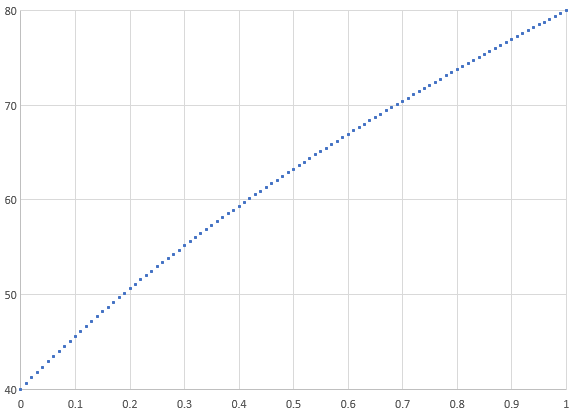
Accelerating train
A train moving at constant acceleration passes by a pink pole near the track. The front end of the train passes the pole going 4 0 km/hr , and then the back end of the train passes it going 8 0 km/hr .
What was the speed at which the middle of the train passed the pole?
This section requires Javascript.
You are seeing this because something didn't load right. We suggest you, (a) try
refreshing the page, (b) enabling javascript if it is disabled on your browser and,
finally, (c)
loading the
non-javascript version of this page
. We're sorry about the hassle.
8 solutions
Moderator note:
If you love science and need somewhere to learn the basics, try out our new course, Science Essentials. This course includes our newest chapter on the fundamentals of motion — including acceleration!
Science Essentials Showcase 2


Energy
Learn about conservation of energy by visiting an amusement park.
Heat Transfer
Explore heat transfer, and the various mechanisms by which it can occur: radiation, conduction, and convection.
Speed, Velocity, and Acceleration
Travel around the city to learn about motion.
Distance and Displacement
Deliver pizzas to learn about scalars and vectors through distance and displacement.




I reached the opposite conclusion by the following reasoning. The train is accelerating. After passing the pole, it is going faster than it was before it passed the pole. It takes less time to cover the distance of half the train length after passing the pole. It takes more time to cover the distance of half the train before reaching the pole. Therefore before reaching the pole, its average speed was less than 60 miles per hour.
Now I see my mistake. The average speed could be less than 60 miles per hour while the speed at the pole could be greater than 60 miles per hour.
If the train's acceleration is a , and the train's length is 2 s , and if its speed at the half-way mark is v , then 8 0 2 − 4 0 2 = 2 a × 2 s = 4 a s v 2 − 4 0 2 = 2 a × s = 2 a s so that 8 0 2 − 4 0 2 = 2 ( v 2 − 4 0 2 ) , and hence v 2 = 2 1 ( 8 0 2 + 4 0 2 ) = 4 0 0 0 , so that v = 2 0 1 0 > 6 0 . Note that we are using kilometres as the unit of distance, and hours as the unit of time.
Log in to reply
If a particle is travelling under constant acceleration a , with starting velocity u , ending velocity v , taking time t to experience a displacement s , then there are five equations that hold. s s s v v 2 = u t + 2 1 a t 2 = v t − 2 1 a t 2 = 2 1 t ( u + v ) = u + a t = u 2 + 2 a s I am using the last of these.
Log in to reply
Thank you for the explanation.
Log in to reply
@Greg Grapsas – You can see it also as equality of potential energy (m * a * 2s) and cinetic energy (0.5 * m (v^2 - u^2))
Log in to reply
@Hamza Senhaji Rhazi – Yes . Thank you
@Hamza Senhaji Rhazi – Well, actually it is the change in kinetic energy 2 1 m ( v 2 − u 2 ) which is equal to the work done m a × s by the force m a producing the constant acceleration.
Nice work.
Good use of one of the linear velocity with constant acceleration equations. I would love to see Arjen Vreugdenhil chime in on this one; I love to see his work also..
Constant acceleration means the amount of energy used to make the train go faster is the same the whole time the train is speeding up. However we know that resistance becomes higher (from wind and wheels against the track) at higher speeds. So the train must be going faster than 60 km/h at the halfway point to be able to reach 80 km/h in the the remainder of the time.
bro. Pass the joint.
Worst answer
Resistance is not taking any role here
Is this solution valid? I am so confused...
Log in to reply
the argument is flawless. The pattern is like this. Some horses are brown. Some shoes are brown. Therefore, some horses are shoes.
"Constant acceleration" presumably takes any air resistance into effect. It's a statement about the change in velocity, not a statment about the force being applied to the vehicle.
Can this be discribed with a simple curve or wave sign to visualise it? I keep thinking of a sign wave. Does that apply for cummulative acceleration?
Log in to reply
Sure it can... for any fraction x of the length of the train, the speed v will be v = v 1 2 + ( v 2 2 − v 1 2 ) × x , which graphs to:

Here is a solution which is not original.
Because the train is accelerating constantly, it must be under the action of constant force. But this means the work done by the train grows in proportion with the distance traveled, since it is simply the product of the force applied with the distance. This work is converted to kinetic energy. So, that means the kinetic energy halfway through is exactly halfway between the initial and final kinetic energies.
Cancelling masses on both sides, we have v = 2 1 ( 4 0 2 + 8 0 2 ) , which by power mean inequality , is larger than 60.
In the accelerated train, the speed at middle point is given by
√[(u^2+v^2)/2] > [(u+v)/2]
i.e. 63.245 > 60.0
Where u=40.0 and v=80.0 are initial and final speeds, respectively.
Try using Latex
it's just a trick question relying on people to confuse velocity and acceleration. we don't really know what speed is or how a 'filmstrip' view of relativistic objects works, only that it more or less works in our day to day reality.
Since the question isn't strictly asking for a specific speed ( only a comparison to the average speed ), we don't need to calculate.
Over the first half of the journey the train will experience an acceleration over some time t and will achieve a change in velocity of Δ v . Over the second half of the journey, the train will accelerate over some time less than t because of:
1) It has a higher average velocity than the first leg
2) traveling over the same distance.
Thus, the train will experience a change in velocity of Δ v − ϵ over the second half of the journey. Adding up the total change in velocity to the initail velocity and equating it to the final velocity we have:
v o + Δ v + ( Δ v − ϵ ) = v f
Where,
Δ v = v 2 L − v o
v o + ( v 2 L − v o ) + ( v 2 L − v o − ϵ ) = v f
Combining like terms and solving for v 2 L ( absorbing the factor of 1/2 into ϵ in the second term fro simplicity )
v 2 L = 2 v f + v o + ϵ
The first term is the average velocity, and we can see the speed of the train at position 2 L is greater than it by some amount ϵ > 0
Let length of train be 2l. Let midpoint of train passes by speed v. Then,applying equations of motion , v^2-40^2=2al(for first half) And 80^2-v^2=2al(2nd half) So, 2v^2=6400+1600 V^2=4000 V=20√10. -Biswaranjan
Constant acceleration means that speed increments by the same amount per unit time. Because it is accelerating, it takes the train more time to pass the pole between the front and the middle than between the middle and the end. Therefore, more time spent means the speed increase must be greater, and so when the middle of the train passes the pole it must be moving faster than 60 km/h